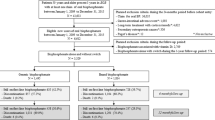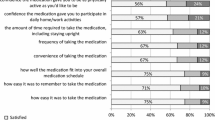Abstract
Summary
Compliance and persistence to bisphosphonates amongst Singaporean patients with osteoporosis were estimated. Mean medication possession ratio (MPR) ± standard deviation (SD) was 78.9 ± 27.5%, and 69.0% was persistent at 1 year. In contrast to US and Europe where poor adherence is noted, our study suggests higher adherence rates to bisphosphonate therapy amongst patients.
Introduction
Adherence to bisphosphonate therapy during treatment of osteoporosis has been reported to be poor. We aimed to estimate the compliance and persistence to prescribed bisphosphonate therapy amongst patients at the largest public restructured hospital in Singapore.
Methods
This is a retrospective analysis of records of patients who were prescribed the two most commonly used oral bisphosphonates—alendronate and risedronate. The study was conducted between January 2007 and December 2008. Prescription and pharmacy refill records of all patients were extracted and matched. Compliance was calculated using the MPR, while persistence, a dichotomous variable, was defined as continuous refill of bisphosphonates for at least 12 months with a permissible gap of 30 days.
Results
Seven hundred ninety-eight patients were included in the study. Mean MPR ± SD was 78.9 ± 27.5%, and 69.0% of the patients were persistent with bisphosphonate therapy at 1 year. The proportion of patients with MPR ≥80% at 6, 12 and 18 months was 90%, 72% and 62%, respectively. Age <69 years was associated with better compliance (OR, 1.34; 95% CI, 0.99–1.82; P = 0.043), and history of fractures was associated with better compliance (OR, 1.38; 95% CI, 1.02–1.87; P = 0.038) and persistence (OR, 1.33; 95% CI, 0.97–1.82; P = 0.046).
Conclusion
In contrast to studies conducted in the US and Europe that show poor adherence, our study suggests higher adherence rates to bisphosphonate therapy amongst Singaporean patients.


Similar content being viewed by others
References
Ministry of Health (2009) Osteoporosis clinical practice guidelines. Ministry of Health, Singapore, p 82 (Jan)
Lau EM (2001) Epidemiology of osteoporosis. Best Pract Res Clin Rheumatol 15(3):335–344
Leong KH (1998) Osteoporosis—the need for a paradigm shift. Ann Acad Med Singapore 27(1):100–104
Lee AY, Chua BS, Howe TS (2007) One-year outcome of hip fracture patients admitted to a Singapore hospital: quality of life post-treatment. Singapore Med J 48(11):996–999
Wong MK et al (2002) Osteoporotic hip fractures in Singapore—costs and patient's outcome. Ann Acad Med Singapore 31(1):3–7
Chen LT et al (2007) Hip fractures in the elderly: the impact of comorbid illnesses on hospitalisation costs. Ann Acad Med Singapore 36(9):784–787
Miller NH (1997) Compliance with treatment regimens in chronic asymptomatic diseases. Am J Med 102(2A):43–49
World Health Organization (2003) Adherence to long-term therapies: evidence for action. World Health Organization, Geneva
Solomon DH et al (2005) Compliance with osteoporosis medications. Arch Intern Med 165(20):2414–2419
Boccuzzi S, Foltz S, Omar M (2005) Assessment of adherence and persistance with daily and weekly dosing regimens of oral bisphosphonates. Osteoporos Int 16:S35–S36
Cramer JA et al (2005) Compliance and persistence with bisphosphonate dosing regimens among women with postmenopausal osteoporosis. Curr Med Res Opin 21(9):1453–1460
Weycker D, Macarios D, Oster G (2005) Adherence with weekly versus daily bisphosphonate therapy among women with postmenopausal osteoporosis. J Bone Miner Res 20(suppl 1):2
Loong TW (1999) Primary non-compliance in a Singapore polyclinic. Singapore Med J 40(11):691–693
Siris ES et al (2006) Adherence to bisphosphonate therapy and fracture rates in osteoporotic women: relationship to vertebral and nonvertebral fractures from 2 US claims databases. Mayo Clin Proc 81(8):1013–1022
Rabenda V, Hiligsmann M, Reginster JY (2009) Poor adherence to oral bisphosphonate treatment and its consequences: a review of the evidence. Expert Opin Pharmacother 10(14):2303–2315
Curtis JR et al (2008) Benefit of adherence with bisphosphonates depends on age and fracture type: results from an analysis of 101,038 new bisphosphonate users. J Bone Miner Res 23(9):1435–1441
Cotte FE et al (2010) Adherence to monthly and weekly oral bisphosphonates in women with osteoporosis. Osteoporos Int 21(1):145–155
Amanda RP et al (2010) The complex relation between bisphosphonate adherence and fracture reduction. J Clin Endocrinol Metab 95(7):9
Netelenbos JC et al (2010) Adherence and profile of non-persistence in patients treated for osteoporosis-a large-scale, long-term retrospective study in The Netherlands. Osteoporos Int (in press)
Pasion EG et al (2007) Comparison of raloxifene and bisphosphonates based on adherence and treatment satisfaction in postmenopausal Asian women. J Bone Miner Metab 25(2):105–113
Hess LM et al (2006) Measurement of adherence in pharmacy administrative databases: a proposal for standard definitions and preferred measures. Ann Pharmacother 40(7–8):1280–1288
Cramer JA et al (2008) Medication compliance and persistence: terminology and definitions. Value Health 11(1):44–47
Yeaw J et al (2009) Comparing adherence and persistence across 6 chronic medication classes. J Manag Care Pharm 15(9):728–740
Caro JJ et al (2004) The impact of compliance with osteoporosis therapy on fracture rates in actual practice. Osteoporos Int 15(12):1003–1008
Papaioannou A et al (2003) Adherence to bisphosphonates and hormone replacement therapy in a tertiary care setting of patients in the CANDOO database. Osteoporos Int 14(10):808–813
Yood RA et al (2003) Compliance with pharmacologic therapy for osteoporosis. Osteoporos Int 14(12):965–968
Grossberg R, Zhang Y, Gross R (2004) A time-to-prescription-refill measure of antiretroviral adherence predicted changes in viral load in HIV. J Clin Epidemiol 57(10):1107–1110
Curtis JR et al (2006) Agreement and validity of pharmacy data versus self-report for use of osteoporosis medications among chronic glucocorticoid users. Pharmacoepidemiol Drug Saf 15(10):710–718
Brankin E et al (2006) The impact of dosing frequency on compliance and persistence with bisphosphonates among postmenopausal women in the UK: evidence from three databases. Curr Med Res Opin 22(7):1249–1256
Huybrechts KF, Ishak KJ, Caro JJ (2006) Assessment of compliance with osteoporosis treatment and its consequences in a managed care population. Bone 38(6):922–928
McCombs JS et al (2004) Compliance with drug therapies for the treatment and prevention of osteoporosis. Maturitas 48(3):271–287
Clowes JA, Peel NF, Eastell R (2004) The impact of monitoring on adherence and persistence with antiresorptive treatment for postmenopausal osteoporosis: a randomized controlled trial. J Clin Endocrinol Metab 89(3):1117–1123
Rabenda V et al (2008) Adherence to bisphosphonates therapy and hip fracture risk in osteoporotic women. Osteoporos Int 19(6):811–818
World Health Organization (2000) Health systems performance. World Health Organization, Geneva
Singapore’s healthcare financing system (2008) Ministry of Health, Singapore. http://www.moh.giv.sg/mohcorp/hcfinancing.aspx?id=104
Hiligsmann M et al (2010) Potential clinical and economic impact of nonadherence with osteoporosis medications. Calcif Tissue Int 86(3):202–210
Recker RR, Gallagher R, MacCosbe PE (2005) Effect of dosing frequency on bisphosphonate medication adherence in a large longitudinal cohort of women. Mayo Clin Proc 80(7):856–861
Elizabeth ER et al (2009) Medication adherence, first episode duration, overall duration and time without therapy: the example of bisphosphonates. Pharmacoepidemiol Drug Saf 18:7
Lo JC et al (2006) Persistence with weekly alendronate therapy among postmenopausal women. Osteoporos Int 17(6):922–928
Farmer KC (1999) Methods for measuring and monitoring medication regimen adherence in clinical trials and clinical practice. Clin Ther 21(6):1074–1090, discussion 1073
Steiner JF, Prochazka AV (1997) The assessment of refill compliance using pharmacy records: methods, validity, and application. J Clin Epidemiol 50:12
Sikka R, Xia F, Aubert RE (2005) Estimating medication persistency using administrative claims data. Am J Manag Care 11:9
Gleeson T et al (2009) Interventions to improve adherence and persistence with osteoporosis medications: a systematic literature review. Osteoporos Int 20(12):2127–2134
Acknowledgements
We would like to thank the SingHealth Integrated Health Information Systems department for their kind assistance in extracting the prescription records and the pharmacy refill records.
Conflicts of interest
None.
Author information
Authors and Affiliations
Corresponding author
Rights and permissions
About this article
Cite this article
Cheen, M.H.H., Kong, M.C., Zhang, R.F. et al. Adherence to osteoporosis medications amongst Singaporean patients. Osteoporos Int 23, 1053–1060 (2012). https://doi.org/10.1007/s00198-011-1635-9
Received:
Accepted:
Published:
Issue Date:
DOI: https://doi.org/10.1007/s00198-011-1635-9




